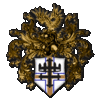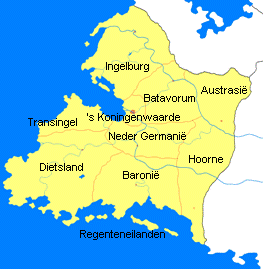Davignonrepublic
| Davignonrepublic davinjonrépublík | |||
|
← | |||
| |||
|
| |||
| Official language: | Batavian | ||
| Capital: | Davignon | ||
| Largest cities: | 's Koningenwaarde, Davignon, Ingelburg | ||
|
| |||
| Population: | 17,367,210 | ||
|
| |||
| Government: | Revolutionary anarchy | ||
| Head of state: | Arkadius I des Vinandy as King (de jure) | ||
| Head of government: | Jonas Windsor (de jure) as Batavian Prime Minister | ||
| Currency: | Kruys | ||
The Davignonrepubliek or Davignonrepublic was a shortlived period of chaos and anarchy in Batavia during 1523 AN. It saw the take-over of many government buildings in several large cities throughout the nation. Under the leadership of Johannes Stalin and Ivan Jermak a series of strikes escalated in open war between police forces and labour unions, while the strikes brought any economic growth to squeaking halt.
While seen as a period of chaos, its direct impact on the daily life of the population was limited to certain regions, but nonetheless viewed as vital for the nation's transformation to a true constitutional monarchy. The departure of Arkadius I, the withdrawal of Regent Jodocus van Haltna from active politics and the rise of Arkadius II to power, would all eventually influence public opinion and avoid a full-blown revolution. Order was restored, the first parliamentary elections held and crisis laws enacted which improved the life of the citizenry.
Background
The civil unrest, which had begun early in 1523 AN, in Davignon, was a direct result of political tensions in the aftermath of the van Haltna Crisis: the Hollander cabinet (1522) had fallen in less than a month, while the First Windsor cabinet failed to boost trust in the political and economical institutions. With the crash of 1518 still fresh in mind, many land owners started a run on the bank, while others decided to cut in wages.
A work incident in a factory in Davignon, with the death of a child as a result, led to protests. The Duke of Davignon, at that moment in 's Koningenwaarde (acting as prime minister), was unable to assist and the police commissar - under heavy pressure of the bourgeoisie - decided to send in the troops. The bloody fights were condemned by all political parties, but it was the Communist Party which started supporting the strikers and rioters with food and funds.
In a matter of weeks, the protests spread throughout the country. Anger about their work situation became a demand of total political reform. The upper class, now alarmed by how the movement was becoming increasingly radical, called upon the government to act swift. As population centres came under control of soviet councils, Davignon became its de facto capital. The Batavian capital, 's Koningenwaarde, was successful in crushing a revolt and negotiated about better labour terms with local unions.
The surprising flight of King Arkadius I shocked the nation: in 1523 he left 's Koningenwaarde with his family, and re-appear in Gascony . Jodocus van Haltna, who after the van Haltna Crisis had avoided too much political attention, was taken aback by the demise of his close friend and left politics. This brought back some of his opponents to the side of the government, which slowly regained control.
The last month of 1523 AN saw the reshuffling of the government into a Second Windsor Cabinet. Reforms were passed to appease the moderates, while the monarchy retained a large part of its emergency powers. The brother of the deceased King was placed on the Throne, while elections were organised.
The disunited soviet councils were brought into line, while its bastion - Davignon - was sieged by the Batavian Armed Forces.
Aftermath
The period of the Davignonrepublic saw the rise of the Second Kingdom of Batavia. While citizens enjoyed increased liberties under the new constitution, trials were held under martial law to imprison the most important traitors. The Communist Party was - for a short while - banned from participating in the elections after its initial successes (gaining 15 of 50 seats in the first meeting of the Lagerhuis).
With violence limited to a few cities and a balanced approach by the King's government and army in subduing the anarchist and communist movements, the newly established constitutional monarchy would soon proof to be the golden era of Batavian culture and wealth. Certain social problems would, however, remain dormant and lead to a later implosion of the Second Kingdom. Davignon, which acted as a hotbed of revolutionary movements, remained the centre of leftist agitation (even during the Sixth Kingdom), despite efforts of the local and central government to arrest and subdue dangerous individuals.



